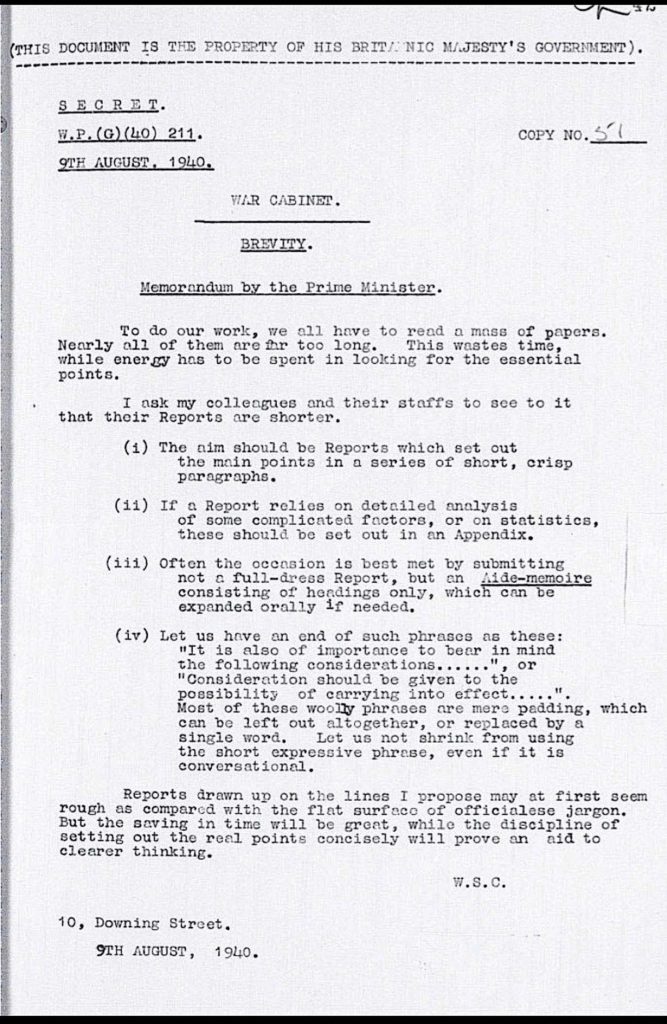“Success is the ability to go from one failure to another with no loss of enthusiasm.”
Traditional.

A popular tool for lean start-ups is the business model canvas. This is an example of one of my favorite things: a one-pager. A one-pager is the distillation of a complex problem, project or issue into one page. Just as important as the output (the one-page summary) is the process that produced it. It’s rare that you don’t move at least a bit ahead by thinking through and writing a one page summary of a complex challenge or problem. One pagers are helpful in many situations. One of my favorite examples is a memo by Winston Churchill written on August 9, 1940 in the midst of the Battle of Britain requesting brevity in all papers and correspondence sent to him [1]: a plea for one-pagers (or less). See Figure 3.
In this post, we will look at a useful one pager for lean analytic start-ups.
The four principles of lean start-ups advocated by Eric Ries in his best selling book The Lean Startup [3] apply without change to analytic start-ups.
- Principle 1: Eliminate uncertainty and waste. This principle reminds us of the importance in a lean start-up of focusing on learning about your customers and learning about your potential market, and using that information to improve your product-market fit in an iterative fashion.
- Principle 2: Work towards a sustainable business model. This principle directly addresses finding a viable and sustainable business model around the products and services being developed.
- Principle 3: Develop a MVP. This principle focuses on developing a minimum viable prototype to learn about how your customers actually use and benefit from your product. I follow others (for example Marty Cagan [4]) and prefer to call this a minimum viable prototype, not a minimum viable product.
- Principle 4: Validated learning. The focus with this principle is to develop and track measures that quantify your progress developing a product and finding the right market for it. As in the quote at the beginning, validated learning is a good way to move quickly from one (or more) failures to something that succeeds.
The business model canvas is a one-pager that was developed initially by Alexander Osterwalder in a blog post in 2005 and popularized through a number of activities and venues, including in a book by Osterwalder and Yves Pigneur in 2010 [5]. A good introduction to the business model canvas is a Harvard Business Review article by Steve Blank called “Why the Lean Start-Up Changes Everything” [6]. Figure 2 is a business model canvas.

A useful question to ask is what are the minimal changes that we can make in the business model canvas to create a business model canvas for a lean analytic start-up. One approach from [2, chapter 10] is shown in Figure 1. Here we make three changes from the standard business model canvas that we describe below.
First, we include the analytic value chain framework from [2] in the canvas. This focuses on four critical activities that provide the foundation for analytics within a company or organization:
- Collecting data. The effort required to get the data needed varies significantly depending upon the project, but is often one of the critical paths.
- Transforming data to create something of value to customers. This can be through analytic or AI modeling, or sometimes, just reformatting the data so that it provides more business value to your customers.
- Monetizing data. From a business model point of view, this is the core question. How to build an analytic product or service, find customers who are willing to pay for it, and develop a sustainable business model around it.
- Protecting your analytics from a competitive standpoint. There are many ways to establish a competitive advantage through analytics, but also many ways to lose it over time, especially as the number of tools and frameworks to build models and the availability of data to train them grows. It is important to think at the beginning how you might protect your analytic product or service over time.
It may be easier to remember this using the acronym (CTMP). Collecting and transforming data is the the core of an analytic business model, so I make it one of the three main vertical boxes in the canvas. For this reason, I relabeled the Revenue Streams box Monetize Data.
The CTMP Framework is a good way to structure four key questions as you think through your analytic start-up and the analytic business model canvas is a nice one-pager to help you visualize it.
I discuss the analytic value chain and the CTMP framework in Chapter 7 of my book: Developing an AI Strategy: a Primer [2]. Note that the analytic business model canvas covered in the book is slightly different than the one above.
The analytic business model canvas in Figure 1 also includes elements of the analytic diamond framework. The analytic diamond looks at data science, analytics, or AI projects from four viewpoints: analytic modeling, analytic operations (AnalyticOps), analytic infrastructure, and analytic strategy. In the analytic business model canvas, I include analytic strategy as a separate box. Analytic operations and analytic infrastructure fit naturally into the Key Activities box in the canvas. Analytic modeling is one of the main ways of transforming data, so it fits naturally into the Collect, Transform and Protect box.

For more information
There is a lot of information on lean startup at the website theleanstartup and the book The Lean Startup is easy to read and inspiring.
Steve Blank’s website has a tremendous amount of useful and practical information about start-ups and entrepreneurship.
For more information about minimum viable prototypes, see Marty Cagan, Inspired: How to Create Tech Products Customers Love.
A popular and thoughtful biography of Winston Churchill is Andrew Robert’s Walking With Destiny. Richard Aldous has written a good review of the book in the New York Times Book Review called: “Is This the Best One-Volume Biography of Churchill Yet Written?”
The quote at the beginning is often misattributed to Winston Churchill, Abraham Lincoln and others, but its origin is hard to pin down its origin. See Appendix I: Red Herrings: False Attributions, Entry: Success is going from failure to failure without losing your enthusiasm, in Richard Langworth, Churchill By Himself: The Definitive Collection of Quotations, PublicAffairs, 2011, for a discussion about the attribution of the quote.
This post is based in part on Chapter 10 of Developing an AI Strategy: a Primer [2]. I cover the Analytic Diamond in Chapter 5 and the CMTP Framework in Chapter 7.
Disclosures
There are no affiliate links in this post, but I do make royalties from the sale of my book Developing an AI Strategy: a Primer.
References
[1] Winston S Churchill, Memorandum, August 9, 1940, Brevity, The National Archives CAB 67/8/11, https://discovery.nationalarchives.gov.uk/details/r/C9135954, accessed on July 10, 2020.
[2] Robert L. Grossman, Developing an AI Strategy: A Primer, Open Data Press, 2020.
[3] Eric Ries, The Lean Startup: How Today’s Entrepreneurs Use Continuous Innovation to Create Radically Successful Businesses Hardcover, Crown Business, 2011.
[4] Marty Cagan, Inspired: How to Create Tech Products Customers Love, Wiley, 2017.
[5] Alexander Osterwalder and Yves Pigneur. Business model generation: A handbook for visionaries, game changers, and challengers. John Wiley & Sons, 2010.
[6] Steve Blank. Why the lean start-up changes everything. Harvard Business Review, 2017.
